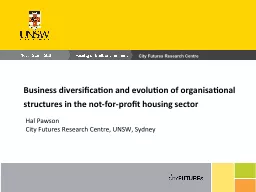

Hal Pawson City Futures Research Centre UNSW Sydney Presentation overview Diversification into community services Diversification into surplusgenerating commercial activities Innovations in organisational structures ID: 544526
Download Presentation The PPT/PDF document "Business diversification and evolution o..." is the property of its rightful owner. Permission is granted to download and print the materials on this web site for personal, non-commercial use only, and to display it on your personal computer provided you do not modify the materials and that you retain all copyright notices contained in the materials. By downloading content from our website, you accept the terms of this agreement.
Slide1
Business diversification and evolution of organisational structures in the not-for-profit housing sector
Hal Pawson
City Futures Research Centre, UNSW, SydneySlide2
Presentation overviewDiversification into ‘community services’Diversification into surplus-generating commercial activities
Innovations in organisational structures
Issues for discussionSlide3
Introduction
‘…move[s
] towards a more business-like or commercial model’ have become a common trend across not-for-profit housing sectors in Australia and Canada as well as the UK (Maclennan et al, 2013 p70
)
NFPs becoming more ‘hybridised’ with growing role in delivering market products and services
‘Non-social housing activities’ >20% of turnover of English HAs by 2013/14
Albeit smaller scale and more recent, some ‘business diversification’ moves made by NFPs in
Aus
and Canada
Important questions raised for practitioners and policymakersSlide4
Community services [1]
Early phase of ‘business diversification’ among UK HAs (1990s) involved community services or ‘wider role’ activities
‘In business for neighbourhoods’ NHF 2003
Shaped by New Labour ‘social inclusion’ imperative
Regulatory/funder encouragement; funding often leveraged from public sources
But also enlightened self-interest for HAs with spatially concentrated portfolios:
‘…just housing the poor without focusing on the wider viability of neighbourhoods is likely to leave associations with increasing residualisation of stock, deteriorating income streams and asset values’ (Lupton & Leach 2011 p18
)Slide5
Community services [2]
Diverse activities characteristic of this UK phase included:
Financial inclusion projects – e.g. supporting credit unions
Youth
activities including sports programs
Community development initiatives
Tenant employability projects such as ICT
training
R
ecent echoes in Australia with some larger providers creating community development positions and budgets
‘
Placemaking
’ obligations attached to recent public housing transfer projects in Qld, SA and
TasSlide6
Tapping new sources of revenue [1]
Motivated by perceived need to reduce dependence on direct
govt
funding – more pressing issue in England from 2010:
‘…associations [have been] under considerable pressure to diversify their activities to include more profitable but more risky private sector initiatives which might produce profits and thus a stream of income which could be used to cross-subsidise their social rented development’
(
Williams & Whitehead, 2015 p 18
)
Condition of retaining access to v limited public funding
Mainly involves new build for open market sale
Other activities include:
Nursing home development and management
Development of housing for management as market rental accommodation
Student housing development and/or
management
But margins may be thin or non-existent:
‘The surplus coming from diversified activities is virtually zero’
(Pete Redman,
Traderisks
– cited by Jules Birch, 14 June 2016)Slide7
Some of Australia’s larger NFP providers also exploring business diversification to broaden revenue baseInterest expressed in aged and disability services, mixed tenure housing development, home ownership products, strata management, real estate services
BHC recent foray into market rental housing
But
‘…many CEO aspirations for new business developments expressed in [2011/12] had not materialised by [2013/14], suggesting that business diversification was more difficult to achieve than anticipated’
(Milligan & Hulse, 2015 p204
)
Similar moves in Canada; recent study of NFP housing reported that case study orgs were:
‘
exploring and implementing ways to commodify their expertise – selling services in marketable expertise, which their roles as social housing developers and property managers have allowed them to develop’
(Pomeroy et al, 2015
pvi
)
Tapping new sources of revenue [2]Slide8
Innovations in organisational structures
Among UK HAs business diversification a stimulus to innovation in corporate structures
Need to quarantine risk
Offloading of commercial activity to retain charitable status
For English HAs, two thirds of non-social housing business (especially development for sale) accounted for via subsidiaries
Group structures more often developed to facilitate mergers
A few of Australia’s larger providers have created group/subsidiary structures linked with mergers or with public housing transfersSlide9
Business diversification and hybridisation: issues for discussion
Mission creep risk:
‘the key question is whether [divergence from a prime focus on social housing] damages the non-profit performance and ethos of the overall non-profit’ (Maclennan et al, 2013 p81
)
Organisational culture and salary structure implications of absorbing senior staff with commercial backgrounds
What can Australian/Canadian NFPs learn from UK counterparts on:
The most promising ‘new business’ prospects in terms of leveraging typical social landlord core capabilities
Priorities for organisational capacity-building
to accommodate new
forms of
business
Approach
to business diversification most
suitable for
organisations lacking substantial capital assets
Recommended
approaches to structuring entities, risk mitigation and change management
How best to navigate the regulatory and charitable status rules that limit or shape permissible ‘diverse activities
’